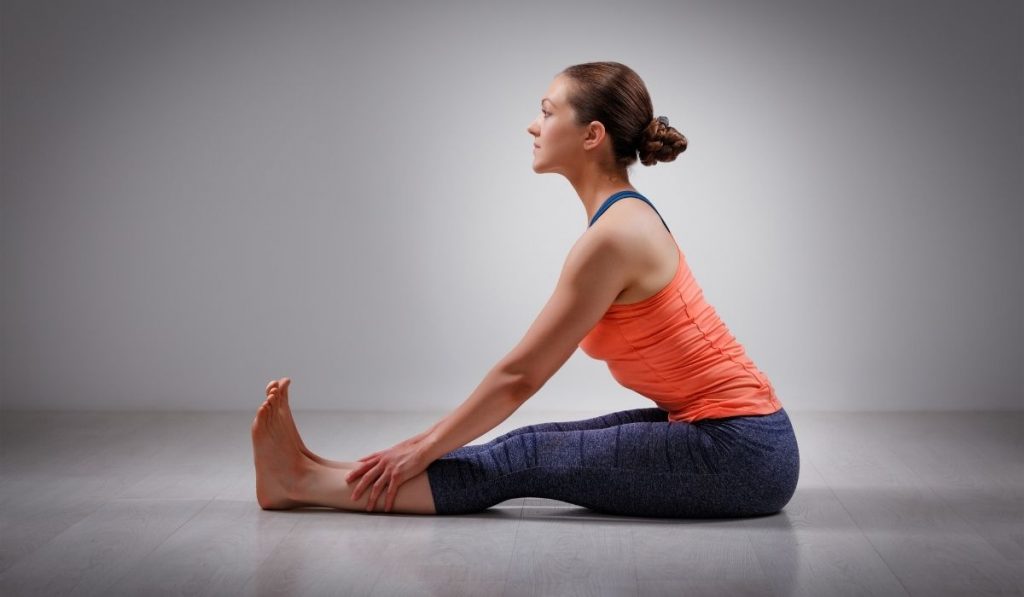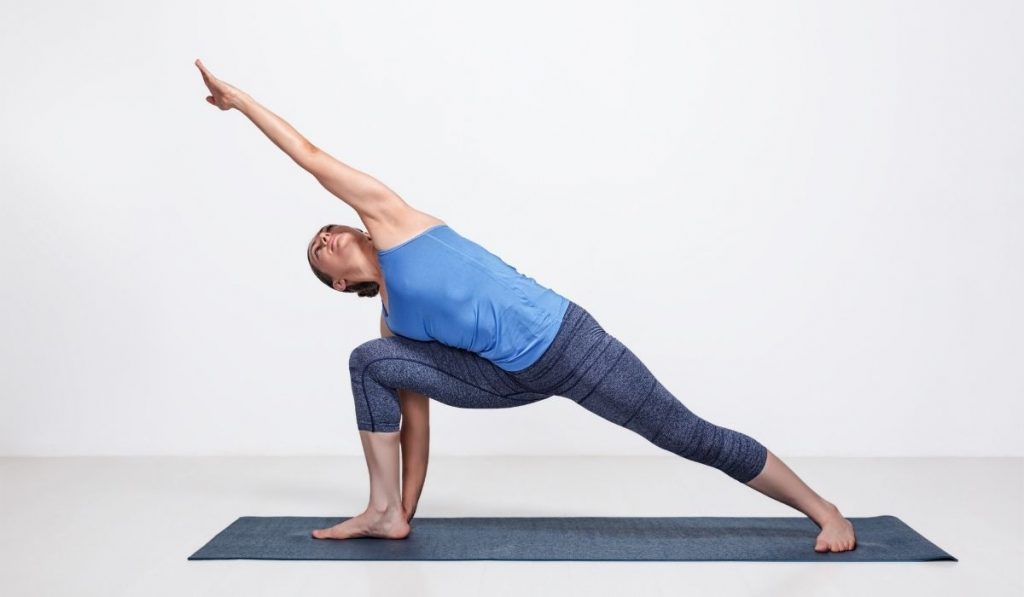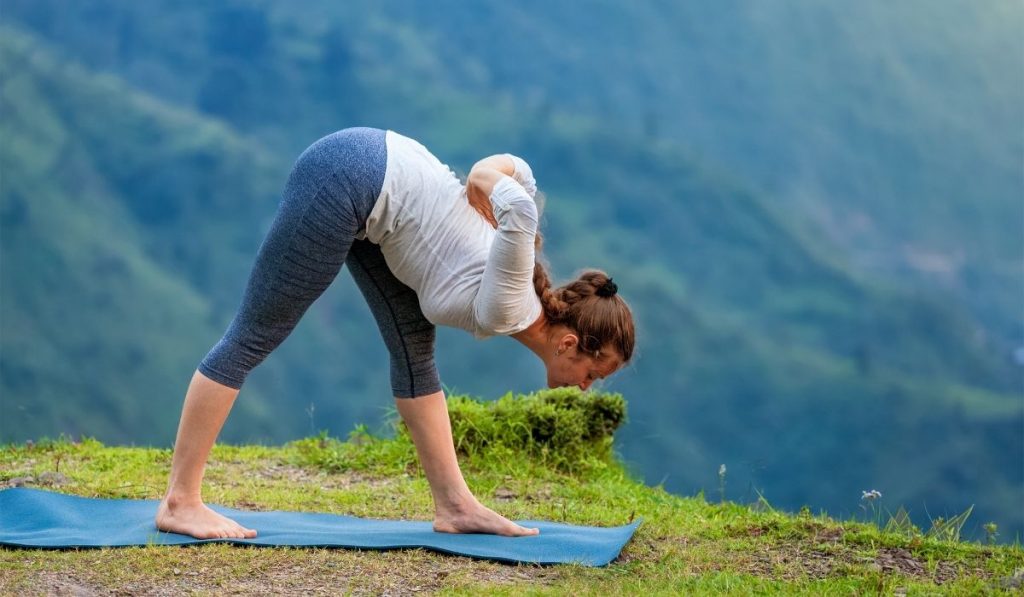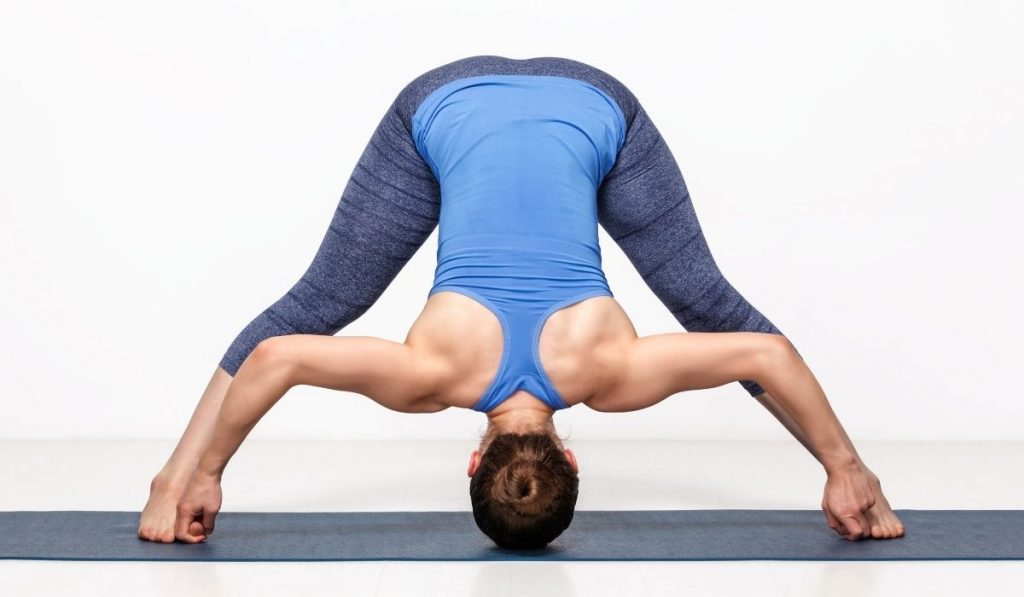Ashtanga yoga is a modernized version of a traditional Indian yoga practice. It involves performing a set of advanced yoga postures that are done in a specific order. This yoga practice focuses on discipline, the flow, and breath between postures, as well as flexibility.
The combination of movements in Ashtanga yoga provides several benefits to your body, including more stable mental and physical health.
Whether you’re a beginner or an experienced yogi, there are various benefits you should know about practicing Ashtanga yoga. So, let’s have a look at each of its advantages one by one!

Table of Contents
15 Benefits
1. Improves mental health
For beginners, Ashtanga yoga can be a difficult yoga practice since it requires intense focus on the position of the foot, hand, and body in order to perform the posture correctly.
However, once you learn the positioning and sequencing by heart, you can do each posture effortlessly which will enable you to focus on the next important thing – the breathing technique called ujjayi breathing.
If practiced properly, Ashtanga yoga will become a powerful meditation to help you manage anxiety and stress. After this meditation, you will feel more calm, relaxed, and free of stress.
2. Helps clear the mind
Aside from improving your mental health, Ashtanga yoga also helps clear your mind. Meditation teaches you to focus on the present, and not about the past or the future. Because of this, it is less likely that you will become stressed about your future, or dwell on your past.
If you can focus your attention on the present, it will improve your decision-making skills, and you will also be able to focus on the task that you’re currently doing instead of worrying about what could happen in the next hours.
Moreover, a clear mind also means more room for creativity. Most Ashtanga yoga students shared that they were able to come up with new ideas while meditating.
3. Boosts cardiovascular health and fitness
Although Ashtanga yoga involves holding different postures, it benefits your cardiovascular system because it keeps your heart rate up to handle the oxygen that it is receiving. This helps strengthen your heart and lungs which improves heart function, lowers blood pressure as well as strengthens the blood vessels in the long term.
If you have a healthy and strong cardiovascular system, it also means that your endurance level when exercising will increase. You may notice that you are now able to practice Ashtanga yoga without becoming too tired. It will also enable you to better practice other types of fitness, including running and jogging.

4. Aids in weight management
Not only does Ashtanga yoga aid in improving your cardiovascular system, but it also helps you lose a few pounds. Since this type of meditation requires your muscles to work for you to hold several postures properly, this means that your body will be able to burn a significant amount of calories. Weight loss will be much easier and more noticeable if you combine meditation with a balanced diet.
If you can maintain a healthy weight, you are less likely to suffer from some health concerns, including stroke, cardiovascular problems, and diabetes.
5. Builds Strength
As mentioned, Ashtanga yoga can be physically challenging because most of its positions will require you to hold your body weight using one hand, or one leg. To accomplish these positions, you will need to dedicate a significant amount of upper and lower body strength. The good thing is that it won’t happen overnight.
Practicing may be hard in the beginning, but as you progress through the series, you will also realize that your core muscles will adapt and improve which will result in a stronger body. Not only will you build strength, but having a strong core will also help correct your posture which will lead to reduced lower back pain.
6. Boosts Resilience
Ashtanga yoga requires you to be mentally strong because learning the complicated postures will require resilience and dedication. It will push you beyond your mental limitations, and it will also test your perseverance and resilience. You won’t last long if you give up once you fail.
Having improved resilience will not only be effective when practicing this type of yoga, but it will also help you better face different challenges in your everyday life.

7. Improves Flexibility
When practicing Ashtanga yoga, you will need to hold each posture for about 5 breaths. This will make sure that your muscles and connective tissues will be stretched, which will lead to improved mobility and flexibility.
With improved flexibility, you will be able to better hold your postures which will then increase your strength. In addition, it will also help reduce the risk of injury while practicing.
8. May Aid in Bone Formation
Another benefit of Ashtanga yoga is that it aids in bone formation. As you may know, the older we grow, the more we become at risk of suffering from osteoporosis. Osteoporosis is a condition wherein the bones get weak which makes them more prone to breaking.
This is especially true for middle-aged, premenopausal women because of the drop in estrogen levels that happens after menopause.
9. Improves Spiritual Well-Being
The benefits of Ashtanga yoga are not just physical and mental. It also improves your spiritual well-being.
There are eight limbs in Ashtanga yoga. The first four limbs, namely the Yamas, Niyamas, Asana, and Pranayama cleanse your exterior and they also teach you how to communicate with the world around you. The other four limbs, namely the Pratyahara, Dharana, Dhyana, and Samadhi emphasize withdrawal, purification, and your own mental relationship, which will guide you through challenges you experience until you acquire mental clarity and a deeper understanding of yourself.

10. Improves Coordination
Since Ashtanga yoga requires you to hold your body in specific positions, it will serve as a powerful tool to improve your balance and coordination. Practicing this type of yoga will provide you with a better sense of rhythm, as well as improve the awareness of flow in your body.
11. Lowers blood pressure
As previously mentioned, ujjayi is a breathing technique that is used in practicing Ashtanga yoga. As you breathe in and out of your nose, a small contraction of the glottis at the back of your throat produces the sound of the ocean.
This helps extend your inhalations and exhalations which results in longer, deeper, and calmer breaths. Over time, this breathing technique lowers blood pressure according to several studies.
12. Helps Develop Discipline
Ashtanga yoga needs consistent practice. Generally, it is practiced six times a week. If that is too much, you can reduce it to twice a week so long as you are consistent with the practice.
You will not be successful if you practiced Ashtanga yoga for a week and end up not practicing for the rest of the month. It will only lead you back to square one. This is the main reason why many students give up on Ashtanga.
If you are serious about practicing this yoga, you will need to have patience, determination, and consistency. If you are able to do it successfully, you will find yourself with improved discipline in all aspects of your life.

13. Reduces Back Pain
Several postures of Ashtanga yoga involve stretching lower back muscles. Since these same postures are practiced regularly, it will help keep the muscles strong which helps reduce lower back pain.
14. Reduces Risk of Injury
Because Ashtanga yoga improves your overall physical, mental, and spiritual health, it will help reduce the risk of injuries, both while doing the actual yoga and while carrying out your daily tasks.
For example, Ashtanga yoga strengthens your tendons, ligaments, and other connective tissues which makes your body more resistant to strains and sprains. It also helps develop bone and muscle strength which will help avoid accidents caused by misuse of joints and muscles.
However, it is vital for you to be mindful of your poses since incorrect postures can lead to injuries.
15. Improves Creativity and Focus
When you feel fully relaxed and calm, which the Ashtanga yoga benefits can provide, your creativity and focus improve. This is because you can concentrate on the present moment, and even if you are not a creative person, your ability to create something from inspiration naturally comes out.
3 Tips for Practicing Ashtanga Yoga
To successfully practice Ashtanga yoga, you will need to have intense discipline and determination because it will be hard in the beginning. Here are some of the tips you can do to help you on your journey:

1. Move at your own pace
If you’re a newbie, Ashtanga yoga can be challenging to practice. Therefore, it is not recommended to overdo it during the first few practices. Instead, learn gradually and be consistent. Small sessions are better than trying to do it in one full session and then being overwhelmed afterward. As Abraham Lincoln said, “I walk slowly, but I never walk backward.”
2. Practice
Aside from memorizing the sequence of postures, perfecting each pose takes a significant amount of practice. It is important that you are aware of what your body feels when doing each pose. Poor positioning and misalignment of the spine can lead to injuries.
3. Focus on yourself
If you are practicing with other experienced yogis, don’t be intimidated. Instead of focusing on others, pay attention to your breathing and your poses. If you compare yourself with others’ progress, you may end up losing your confidence.
Perfecting Ashtanga yoga takes a lot of hard work, patience, and persistence. If you are able to practice it successfully, you will be rewarded with the benefits mentioned above, and it will also help you lead a happier and healthier life.
References:
- https://origympersonaltrainercourses.co.uk/blog/ashtanga-yoga
- https://www.insider.com/ashtanga-yoga
- https://ashtangayogagirl.com/ashtanga-yoga-benefits/
- https://www.masterclass.com/articles/ashtanga-yoga-explained#what-are-3-principles-of-ashtanga-yoga
- https://jonasmuthoni.com/blog/benefits-of-ashtanga-yoga/
- https://www.mindbodygreen.com/articles/what-is-ashtanga-yoga
- https://yogamyoldfriend.com/10-wonderful-ashtanga-yoga-benefits/
- https://www.masterclass.com/articles/ashtanga-yoga-explained#what-are-3-principles-of-ashtanga-yoga
